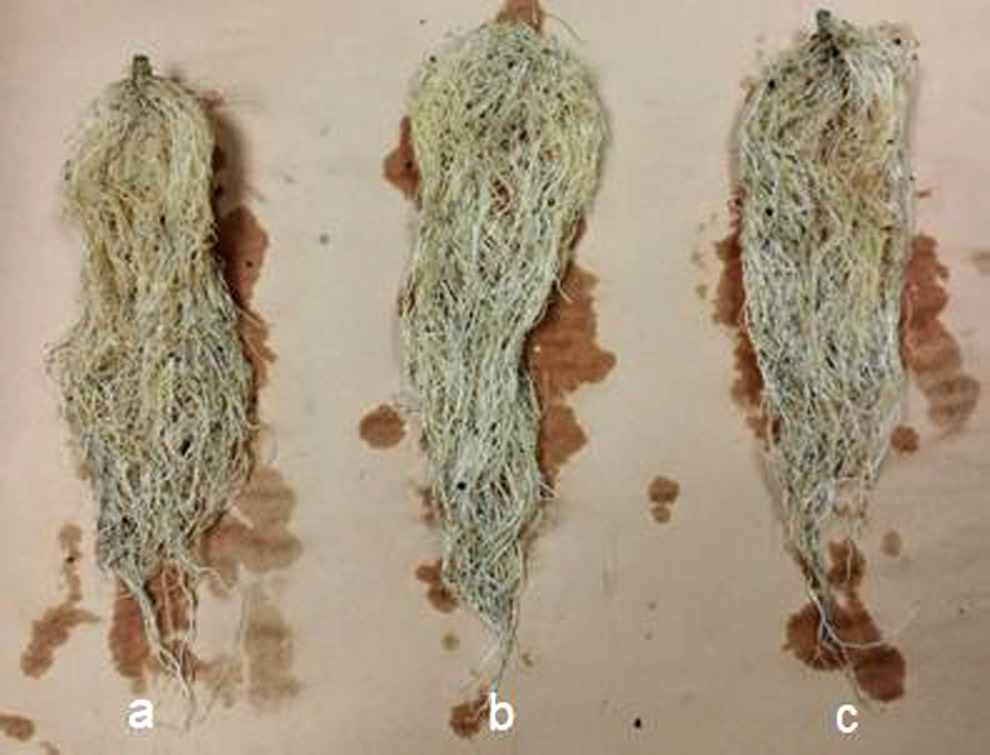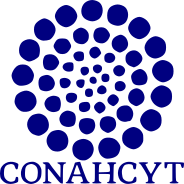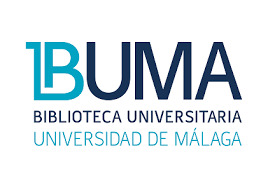Evaluation of the responses of three tomato varieties (Solanum lycopersicum L.) inoculated with bacteria when grown under stress conditions due to wastewater and copper sulfate
DOI:
https://doi.org/10.18387/polibotanica.60.16Palavras-chave:
water pressure, wastewater, bioremediation, bacterial consortia, tomato VarietiesResumo
The objective of this research was to evaluate the responses of three varieties of Solanum lycopersicum L., inoculated with bacterial strains and exposed to stress conditions by wastewater and copper sulfate under greenhouse conditions within the facilities of the Montecillo Graduate School Campus. Texcoco, Mexico. The experimental design used was completely randomized blocks with a factorial arrangement, with three replications and two levels of copper sulfate (with and without). Sulfate is a compound found in nature. It is found naturally in water in different quantities. The water may taste bitter if it contains a large amount of sulfate. Sulfates are also found in minerals, soil, rocks, plants, and foods. CuSO4·5H2O and its use in agriculture. This forms large, bright blue crystals containing five water molecules (CuSO4∙5H2O), also known as blue vitriol. Anhydrous salt is created by heating the hydrate to 300 °F (150 °C). Cupric sulfate is mainly used for agricultural purposes as a pesticide, germicide, feed additive, and soil additive.
Two types of soil irrigated with two irrigation sources (wastewater and clean water), three bacterial consortia, and three varieties of tomato lycopersicum (two improved and one native peasant) were used to compare the effect on physiological growth development.
Analyses of variance and mean comparisons were performed (Tukey, p ≤ 0.05). Using bacterial consortia, the crop's development was promoted under stress conditions by copper and in soils historically irrigated with wastewater for 120 days. In the R.G. 22 variety, the bacterial consortium (1) of pment of the plant, in the R.G. 19 variety, the best response occurred with the use of bacterial consortium 3 (A, D, A7), in the R.N. 22 variety and the use of the two bacterial consortia (1 and 3) favored the development of seedlings. The evaluations of the greenhouse seedling response to inoculation were similar, so the two evaluations allowed to verify that bacterial consortia 1 and 3 had a positive effect on seedling development. The R.G. 22 variety, through the use of bacterial consortium one that includes the bacteria P. putida, P. fluorescens, and A9, presented significant differences in the control treatment. The length of the stem and 3% diameter of the stem were increased, the length was increased by 14% and volume by 33% of the root, and the dry biomass of the aerial part increased by 14%, with respect to the control. In the R.G. 19 variety, through bacterial consortium 3, there was a 25% increase in stem length, 7% in root, 13% in the dry biomass of the aerial part, and 25% in leaf area. In the R.N. 22 variety, through the use of consortia 1 and 3, there was an increase in the number of leaves, 20% length and 60% root biomass, and 17% in the dry biomass of the aerial part, compared to the control.
Referências
Antar, M., Gopal, P., Msimbira, L. A., Naamala, J., Nazari, M., Overbeek, W., et al. (2021a). Inter-organismal signaling in the rhizosphere, in Rhizosphere Biology: Interactions Between Microbes and Plants (Singapore: Springer), 255–293. doi: 10.1007/978-981-15-6125-2_13
A. Zaidi, M.S. Khan (eds.), Microbial Strategies for Vegetable Production, DOI 10.1007/978-3-319-54401-4_6
Backer, R.; Rokem, J.S.; Ilangumaran, G.; Lamont, J.; Praslickova, D.; Ricci, E.; Subramanian, S.; Smith, D.L.(2018 ). Plant growthpromoting rhizobacteria: Context, mechanisms of action, and roadmap to commercialization of biostimulants for sustainable agriculture. Front. Plant Sci. 2018, 9, 1473. https://doi.org/10.3389/fpls.2018.01473 PMid:30405652 PMCid:PMC6206271
Calvo, P.; Nelson, L.; Kloepper, J.W. (2014). Agricultural uses of plant biostimulants. Plant Soil 2014, 383, 3-41. https://doi.org/10.1007/s11104-014-2131-8
Carrillo Castañeda, G., Juárez Muñoz, J., Ruiz Landa, D., & Müller García, R. (2000). Aumento del rendimiento de tomate (Lycopersicon esculentum Mill) cuando la raíz se desarrolla colonizada por microorganismos. Biotecnología Aplicada, 17(3), 171-176. Obtenido de http://www.bioline.org.br/request?ba00051
Casierra Posada, F., Peña Z, G. R., & Peña Olmos, J. E. (2008). Estimación indirecta del área foliar en Fragaria vesca L., Physalis peruviana L., Acca sellowiana (Berg.) Burret, Rubus glaucus L., Passiflora mollissima (Kunth) L. H. Bailey y Ficus carica L. Revista U.D.C.A Actualidad & Divulgación Científica, 11(1), 95-102. https://doi.org/10.31910/rudca.v11.n1.2008.606
Castillo, R., More, F., Cornejo, M., Fernández, J., & Mialhe, E. (2020). Aislamiento de bacterias con ptencial biorremediador y análisis de comunidades bacterianas de zona impactada por derrame de petróleo en Condorcanqui-Amazonas-Perú. Revista de Investigaciones Altoandinas, 22(3), 215-225. doi:http://dx.doi.org/10.18271/ria.2020.656
Daza Martínez, Y. M. (2021). Aislamiento de rizobacterias asociadas a tomate (Solanum lycopersicum L.) y su potencial para promover crecimiento vegetal. Colegio de Postgraduados. Postgrado en Edafología., Texcoco, Estado de México. Obtenido de http://colposdigital.colpos.mx:8080/jspui/bitstream/handle/10521/4960/Daza_Martinez_YM_MC_Edafologia_2021.pdf;jsessionid=EC0B54A52AC9A4FC6271809BB5FECB38?sequence=1
De Andrade, L.A.; Santos, C.H.B.; Frezarin, E.T.; Sales, L.R.; Rigobelo, E.C.( 2023). Plant growth-promoting rhizobacteria for sustainable agricultural production. Microorganisms 2023, 11, 1088. https://doi.org/10.3390/microorganisms11041088 PMid:37110511 PMCid:PMC10146397
Edward Paice.(2022). By 2050, a Quarter of the World's People Will Be African-This Will Shape Our Future. 2022. https://www.theguardian.com/global- Development/2022/jan/20/by-2050-a-quarter-of-the-worlds-people-will-beafrican-this-will-shape-our-future.
Furtak, K., Wolińska, A. The impact of extreme weather events as a consequence of climate change on the soil moisture and on the quality of the soil environment and agriculture – A review, CATENA, Volume 231, 2023, 107378, ISSN 0341-8162, https://doi.org/10.1016/j.catena.2023.107378. (https://www.sciencedirect.com/science/article/pii/S0341816223004691)
Gai, Z.; Zhang, M.; Zhang, P.; Zhang, J.; Liu, J.; Cai, L.; Yang, X.; Zhang, N.; Yan, Z.; Liu, L.; et al. 2-Oxoglutarate Contributes to the Effect of Foliar Nitrogen on Enhancing Drought Tolerance during Flowering and Grain Yield of Soybean. Sci. Rep. 2023, 13, https://doi.org/10.1038/s41598-023-34403-5 PMid:37142711 PMCid:PMC101600607274.
Gupta, B.; Huang, B.(2014). Mechanism of Salinity Tolerance in Plants: Physiological, Biochemical, and Molecular Characterization. Int.J. Genom. 2014, 701596. https://doi.org/10.1155/2014/701596 PMid:24804192 PMCid:PMC3996477
Hasan, A.; Tabassum, B.; Hashim, M.; Khan, N. Role of Plant Growth Promoting Rhizobacteria (PGPR) as a Plant Growth Enhancer for Sustainable Agriculture: A Review.
Bacteria 2024, 3, 59–75. https://doi.org/10.3390/bacteria3020005
Hassanisaadi, M.; Bonjar, G.H.S.; Hosseinipour, A.; Abdolshahi, R.; Barka, E.A.; Saadoun, I. (2021). Biological Control of Pythium aphanidermatum, the Causal Agent of Tomato Root Rotby Two Streptomyces Root Symbionts. Agronomy 2021, 11, 846 https://doi.org/10.3390/agronomy11050846
He, Y.; Pantigoso, H.A.; Wu, Z.; Vivanco, J.M. (2019). Co-inoculation of Bacillus sp. and Pseudomonas putida at different development stages acts as a biostimulant to promote growth, yield and nutrient uptake of tomato. J. Appl. Microbiol. 2019, 127, 196-207. https://doi.org/10.1111/jam.14273 PMid:30955229
Keeler, B.L.; Gourevitch, J.D.; Polasky, S.; Isbell, F.; Tessum, C.W.; Hill, J.D.; Marshall, J.D. The Social Costs of Nitrogen. Sci. Adv. 2016, 2, e1600219. https://doi.org/10.1126/sciadv.1600219 PMid:27713926 PMCid:PMC5052012
Khatoon, Z.; Huang, S.; Rafique, M.; Fakhar, A.; Kamran, M.A.; Santoyo, G.(2020). Unlocking the potential of plant growth-promoting rhizobacteria on soil health and the sustainability of agricultural systems. J. Environ. Manag. 2020, 273, https://doi.org/10.1016/j.jenvman.2020.111118 PMid:32741760
Kumar, A.; Maurya, B.R.; Raghuwanshi, R.; Meena, V.S.; Islam, M.T.(2017). Co-inoculation with Enterobacter and Rhizobacteria on Yield and Nutrient Uptake by Wheat (Triticum aestivum L.) in the Alluvial Soil Under Indo-Gangetic Plain of India. J. Plant Growth Regul. 2017, 36, 608-617. https://doi.org/10.1007/s00344-016-9663-5
Lipper, L.; Thornton, P.; Campbell, B.M.; Baedeker, T.; Braimoh, A.; Bwalya, M.; Caron, P.; Cattaneo, A.; Garrity, D.; Henry, K. et al.(2014). Climate-smart agriculture for food security. Nat. Clim. Change 2014, 4, 1068-1072. https://doi.org/10.1038/nclimate2437
Lyu, D.; Zajonc, J.; Pagé, A.; Tanney, C.A.; Shah, A.; Monjezi, N.; Msimbira, L.A.; Antar, M.; Nazari, M.; Backer, R.; et al.(2021). Plant holobiont theory: The phytomicrobiome plays a central role in evolution and success. Microorganisms 2021, 9, 675. https://doi.org/10.3390/microorganisms9040675 PMid:33805166 PMCid:PMC8064057
Megías, M., Molist, P., & Pombal, M. A. (2018). Atlas de histología vegetal y animal. Departamento de Biología Funcional y Ciencias de la Salud. Facultad de Biología. Universidad de Vigo. Obtenido de https://mmegias.webs.uvigo.es/
Mohammadipanah, F.; Dehhaghi, M. (2017). Classification and Taxonomy of Actinobacteria. In Biology and Biotechnology of Actinobacteria;Springer: Berlin/Heidelberg, Germany, 2017; pp. 51-77. https://doi.org/10.1007/978-3-319-60339-1_4 PMCid:PMC6130666
Montaño, I., Valenzuela, I., & Villavicencio, K. (2021). Competitividad del tomate rojo de México en el mercado internacional: análisis 2003-2017. Revista Mexicana de Ciencias Agrícolas, 12(7), 1185-1197. https://doi.org/10.29312/remexca.v12i7.2531
Morales, I., & Castillo, H. (2009). Cultivo de tomate. Fundesyram, San Salvador, El Salvador. Obtenido de https://fundesyram.info/wp-content/uploads/2020/02/guia_tomate_organico.pdf
Moreno Reséndez, A., García Mendoza, V., Reyes Carrillo, J. L., Vásquez Arroyo, J., & Cano Ríos, P. (2018). Rizobacterias promotoras del crecimiento vegetal: una alternativa de biofertilización para la agricultura sustentable. Revista Colombiana de Biotecnología, 20(1), 68-83. https://doi.org/10.15446/rev.colomb.biote.v20n1.73707
Osakabe, Y.; Osakabe, K.; Shinozaki, K.; Tran, L.S.P. (2014). Response of plants to waters tress. Front. Plant Sci. 2014, 5, 86. https://doi.org/10.3389/fpls.2014.00086 PMid:24659993 PMCid:PMC3952189
Pareek, A.; Dhankher, O.P.; Foyer, C.H. (2020). Mitigating the Impact of Climate Change on Plant Productivity and Ecosystem Sustainability; Oxford University Press: Oxford, UK, 2020. https://doi.org/10.1093/jxb/erz518 PMid:31909813 PMCid:PMC6945998
Rivett, D.W.; Jones, M.L.; Ramoneda, J.; Mombrikotb, S.B.; Ransome, E.; Bell, T. Elevated Success of Multispecies Bacterial Invasions Impacts Community Composition during Ecological Succession. Ecol. Lett. 2018, 21, 516-524. https://doi.org/10.1111/ele.12916 PMid:29446215
Rodríguez-Caballero, E.; Castro, A.J.; Chamizo, S.; Quintas-Soriano, C.; Garcia-Llorente, M.; Cantón, Y.; Weber, B. Ecosystem Services Provided by Biocrusts: From Ecosystem Functions to Social Values. J. Arid. Environ. 2018, 159, 45-53. https://doi.org/10.1016/j.jaridenv.2017.09.005
Rolli, E.; Marasco, R.; Vigani, G.; Ettoumi, B.; Mapelli, F.; Deangelis, M.L.; Gandolfi, C.; Casati, E.; Previtali, F.; Gerbino, R.; et al. Improved Plant Resistance to Drought Is Promoted by the Root-Associated Microbiome as a Water Stress-Dependent Trait: Root Bacteria Protect Plants from Drought. Environ. Microbiol. 2015, 17, 316-331.
Sánchez López, D. B., Gómez Vargas, R. M., Garrido Rubiano, M. F., & Bonilla Buitrago, R. R. (2012). Efecto de la inoculación con bacterias promotoras de crecimiento vegetal sobre el cultivo de tomate (Solanum Lycopersicum var. Sofía) bajo invernadero. Revista Mexicana de Ciencias Agrícolas, 3(7), 1401-1415. https://doi.org/10.29312/remexca.v3i7.1346
Shah, A.; Nazari, M.; Antar, M.; Msimbira, L.A.; Naamala, J.; Lyu, D.; Rabileh, M.; Zajonc, J.; Smith, D.L. PGPR in agriculture: A sustainable approach to increasing climate change resilience. Front. Sustain. Food Syst. 2021, 5, 667546 https://doi.org/10.3389/fsufs.2021.667546
Torres, D. (2003). El papel de los microorganismos en la biodregadación de compuestos tóxicos. Ecosistemas, 12(2), 1-5. https://www.redalyc.org/pdf/540/54012219.pdf
United Nations. 2019. Population Facts December 2019 | No. 2019/6
Vacheron, J.; Desbrosses, G.; Bouffaud, M.-L.; Touraine, B.; Moënne-Loccoz, Y.; Muller, D.; Legendre, L.; Wisniewski-Dyé, F.; Prigent-Combaret, C. Plant growth-promoting rhizobacteria and root system functioning. Front. Plant Sci. 2013, 4, 356. https://doi.org/10.3389/fpls.2013.00356
Warnock, R., Valenzuela, J., Trujillo, A., Madriz, P., & Gutiérrez, M. (2006). Área foliar, componentes del área foliar y rendimiento de seis genotipos de caraota. Agronomía Tropical, 56(1), 21-42. Obtenido de https://ve.scielo.org/scielo.php?script=sci_arttext&pid=S0002-192X2006000100002

Downloads
Publicado
Licença
Copyright (c) 2025 POLIBOTANICA

Este trabalho está licenciado sob uma licença Creative Commons Attribution-NonCommercial-ShareAlike 4.0 International License.

Polibotánica por Departamento de Botánica de la Escuela Nacional de Ciencias Biológicas del Instituto Politécnico Nacional se distribuye bajo una Licencia Creative Commons Atribución-NoComercial-CompartirIgual 4.0 Internacional.



















